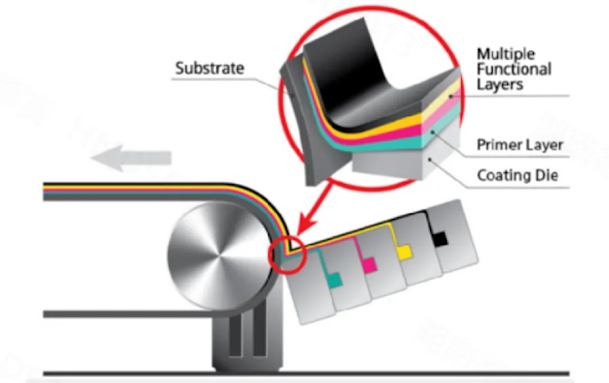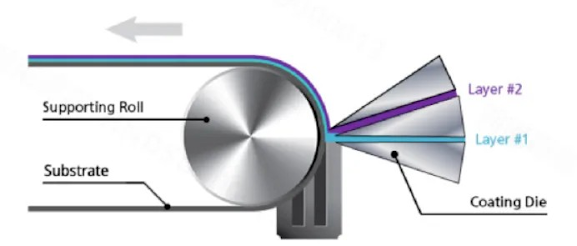Lithium battery double-layer coating technology principle
Double-layer coating is a multi-layer microstructure design for lithium-ion battery pole pieces to improve electrode performance, such as:
(1) Through the fine design of the electrode layer, a "high-speed channel for ions and electrons" is constructed to reduce the diffusion resistance of lithium ions and slow down the capacity decay;
(2) By adjusting the gradient distribution of the porous structure of the electrode, a high porosity structure is achieved in the upper layer and a high compaction density structure in the lower layer, perfectly balancing the dual cores of high energy density and super fast charging.
1. Technical Principle
Double-layer structure design : The positive or negative electrode material is divided into two layers, the bottom layer is a high-conductivity material (such as conductive carbon, graphene), and the upper layer is a high-capacity active material (such as ternary material NCM, silicon-based negative electrode). Through layered coating, both conductivity and capacity are taken into account.
(1) Binder layered structure : When the coating is dried, the binder will migrate to the surface due to capillary force, and as the coating speed increases and the coating thickness increases, the migration of the binder during the drying process becomes more serious, which will further weaken the adhesion between the dressing and the current collector, and have a negative impact on the battery performance. To solve this problem, the bottom slurry in the double-layer structure can be compensated with a high ratio of binder. Taking the above problems into consideration, under normal circumstances, when designing the formula for the upper and lower layers of coating, the proportion of the binder in the lower layer should be appropriately increased to meet the adhesion between the lower coating slurry and the current collector. The proportion of the binder in the upper layer can be appropriately reduced and released to the main material to increase the proportion of the main material in the electrode. A higher proportion of the main material can provide higher capacity and energy density.
(2) Conductive agent layered structure : Study the effect of the conductive agent content in each layer of the two-layer LFP pole piece on the battery performance. The electrochemical performance test results show that when the total conductive agent content remains unchanged at 5%, the pole piece with a high conductive agent content in the lower layer close to the current collector has better performance. As shown in Figure 1, compared with the upper layer with a high conductive agent content (Figure a), the lower layer with a higher conductive agent content (Figure b) can form more conductive pathways, the pole piece has a low electron transfer resistance, and the battery rate performance and cycle stability are improved. Based on this, when designing the double-layer coating formula, as shown in Figure 2, the proportion of the lower layer conductive agent needs to be increased . At the same time, considering the conduction characteristics of electrons in different conductive agents CNT (line conduction) and SP (point conduction), the proportion of CNT in the lower layer is usually higher than that of SP; the total proportion of the conductive agent coated on the upper layer can be appropriately reduced , but the proportion of SP needs to be appropriately increased and the proportion of CNT reduced.
(3) Active particle type and particle size stratification : Utilize the different characteristics of the active material itself, such as high energy density type and high power type, to design a multi-layer structure electrode, and simultaneously achieve high energy density and high power characteristics of the battery. In addition, by using different active material forms, the structure can be controlled, such as different particle size distributions of active materials. Different experimental designs can be carried out to prove which structure is the best. After the unremitting efforts of our predecessors, it can be concluded that the electrode with small particles on the collector side and large particles on the diaphragm side has the best performance .
(4) Porosity layered structure : Double-layer structure positive electrode sheet with gradient porosity. As shown in Figure 4, there are three types of gradient electrodes (no gradient, upright gradient orientation, and inverted gradient orientation). The special structure of the electrode and the reasonable porosity distribution are conducive to the migration of lithium ions inside the thick electrode, thus having better electrochemical performance at high current density. The electrochemical performance test shows that the lower layer with low pores and the upper layer with high pores can effectively reduce the degree of , improve the energy density, and obtain better cycle and rate performance. For this pore size gradient structure electrode, the electrode with large pore size on the diaphragm side and small pore size on the current collector side has the best performance , followed by the electrode with uniform pore size, and the electrode with small pore size on the diaphragm side and large pore size on the current collector side has the worst performance.Figure 4Process flow : Usually two coating steps are used, the bottom layer is coated and then dried before coating the upper layer, or multi-layer extrusion coating technology is used to achieve simultaneous coating, and the thickness of each layer and the interface bonding need to be precisely controlled. The main coating technologies are as follows:
(1) Sliding multi-layer coating:
(2) Curtain multilayer coating:
(3) Die extrusion multi-layer coating:
Lithium-ion battery electrodes generally use the third die extrusion multi-layer coating method. Uniform coating can only be obtained within a certain coating process window, that is, for a specific slurry system, there is a maximum possible coating speed at a certain coating thickness. If the coating speed exceeds this value, the coating is unstable; there is a minimum coating thickness at a certain coating speed, and the coating is unstable if the thickness is smaller.
Compared with single-layer coating, double-layer coating has a smaller process window. The main problems include: (1) Air entrainment from the upstream direction is one of the main causes of coating defects; (2) The mixing of the upper and lower slurries leads to coating instability. Therefore, double-layer coating requires optimization of coating process parameters and study of the effects of differences in viscosity, surface tension, etc. of the two slurries on coating quality.
2. Core advantages
Performance improvements :
Rate performance : The bottom layer of highly conductive material reduces internal resistance and supports fast charging and discharging.
Energy density : The upper layer of high-capacity materials increases the active material load and improves the volume/mass energy density.
Cycle life : Reduce the corrosion of electrolyte to current collector and buffer volume expansion (such as silicon-based negative electrode).
Process flexibility : Parameters (such as slurry viscosity, drying temperature) can be optimized for each layer of material to reduce defects such as cracking.
Summarize
The double-layer coating technology provides an important path for breakthroughs in lithium battery performance through the collaborative innovation of materials and processes. Despite the challenges of cost and process complexity, it has broad application prospects in the fields of power batteries and high energy density. In the future, combined with intelligent manufacturing and sustainable design, it is expected to become one of the core technologies of the next generation of batteries.
Canrd Brief Introduce
Canrd use high battery R&D technology(core members are from CATL) and strong Chinese supply chain to help many foreign companies with fast R&D. We provide lab materials,electrodes, custom dry cells, material evaluation, perfomance and test, coin/pouch/cylindrical cell equipment line, and other R&D services.
Email:janice@canrd.com
Phone/Wechat/WhatsApp/Skype:+86 18928276992
Website : www.canrud.com
















No comments:
Post a Comment